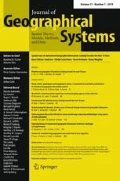Abstract
The aim of the paper is to model small scale neighbourhood in a house price model by implementing the newest methodology in spatial econometrics. A common problem when modelling house prices is that in practice it is seldom possible to obtain all the desired variables. Especially variables capturing the small scale neighbourhood conditions are hard to find. If there are important explanatory variables missing from the model, the omitted variables are spatially autocorrelated and they are correlated with the explanatory variables included in the model, it can be shown that a spatial Durbin model is motivated. In the empirical application on new house price data from Helsinki in Finland, we find the motivation for a spatial Durbin model, we estimate the model and interpret the estimates for the summary measures of impacts. By the analysis we show that the model structure makes it possible to model and find small scale neighbourhood effects, when we know that they exist, but we are lacking proper variables to measure them.
Similar content being viewed by others
Notes
Apartments which are located in the same building will have the same xc, yc-coordinates. This causes a technical problem when creating the nearest-neighbours weights matrix. Therefore the last digit of the seven digits xc-coordinate was increased by one, for one of the apartments. For the other apartment at the same location the yc-coordinate was decreased by one. When there was a third apartment at the same location its coordinates were left unchanged. In data used here the problem concerned less than 20 cases of 649.
References
Anselin L (1988) Spatial econometrics: methods and models. Kluwer Academic Publishers, Dordrecht
Berg L (2002) Prices and constant quality price indexes for multi–dwelling and commercial buildings in Sweden. Uppsala, Uppsala universitet, Department of Economics, Working Paper 2002:2
Case B, Clapp J, Dubin R, Rodriguez M (2004) Modeling spatial and temporal house price patterns: a comparison of four models. J Real Estate Finance Econ 29(2):167–191
Dubin R (1988) Estimation of regression coefficients in the presence of spatially autocorrelated error terms. Rev Econ Stat 70(3):466–474
Karakozova O (2005) Modelling and forecasting property rents and returns. Dissertation, Ekonomi och Samhälle, Publications of the Swedish School of Economics and Business Administration, Nr 149, Helsinki
Kiel KA, Zabel JE (2007) Location, location, location: the 3L approach to house price determination. J Hous Econ 17(2):175–190
Laakso S (1997) Urban housing prices and the demand for housing characteristics. A study on housing prices and willingness to pay for housing characteristics and local public goods in the Helsinki Metropolitan area. Helsinki, Elinkeinoelämän tutkimuslaitos, 27
LeSage JP, Pace RK (2009) Introduction to spatial econometrics. CRC Press, Taylor and Francis Group, Boca Raton
LeSage JP (2010) Spatial econometric toolbox for Matlab, http://www.spatial-econometrics.com
Leonard T, Murdoch JC (2009) The neighborhood effects of foreclosure. J Geogr Syst 11(4):317–332
Pace RK, Barry R, Sirmans CF (1998) Spatial statistics and real estate. J Real Estate Finance Econ 17(1):15–113
Pace RK, Gilley OW (1997) Using the spatial configuration of the data to improve estimation. J Real Estate Finance Econ 14(3):333–340
Pace RK, LeSage JP (2006) Interpreting spatial econometric models. Paper presented at the Regional Science Association International North American meeting, Toronto Ontario, Canada
Pace RK, LeSage JP (2008a) Biases of OLS and spatial Lag models in the presence of an omitted variable and spatially dependent variables. (February 19, 2008). Available at SSRN: http://www.ssrn.com/abstract=1133438
Pace RK, LeSage JP (2008b) A spatial hausman test. Econ Lett 101(3):282–284
Rosen S (1974) Hedonic prices and implicit markets: product differentiation in pure competition. J Polit Econ 82(1):34–55
Smith TE, Wu P (2009) A spatio-temporal model of housing prices based on individual sales transactions over time. J Geograph Syst 11(4):333–355
Tsutsumi M, Seya H (2009) Hedonic approaches based on spatial econometrics and spatial statistics: application to evaluation of project benefits. J Geogr Syst 11(4):357–380
Turnbull GK, Dombrow J, Sirmans CF (2006) Big house, little house: relative size and value. Real Estate Econ 34(3):439–456
Wilhelmsson M (2002) Spatial models in real estate economics. Hous Theory Soc 19(2):92–101
Acknowledgments
I sincerely thank my two anonymous referees for the time and effort they have spent on the manuscript. I am most grateful for all comments and suggestions. Financial support from Victoriastiftelsen and Bröderna Lars och Ernst Krogius forskningsfond are gratefully acknowledged.
Author information
Authors and Affiliations
Corresponding author
Rights and permissions
About this article
Cite this article
Gerkman, L. Empirical spatial econometric modelling of small scale neighbourhood. J Geogr Syst 14, 283–298 (2012). https://doi.org/10.1007/s10109-011-0147-7
Received:
Accepted:
Published:
Issue Date:
DOI: https://doi.org/10.1007/s10109-011-0147-7




